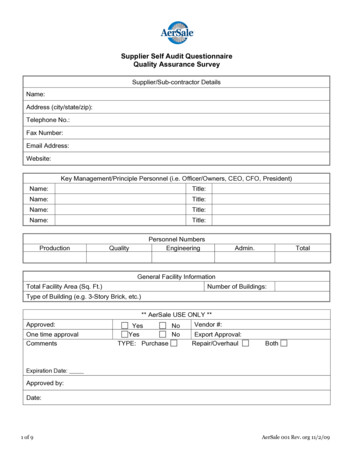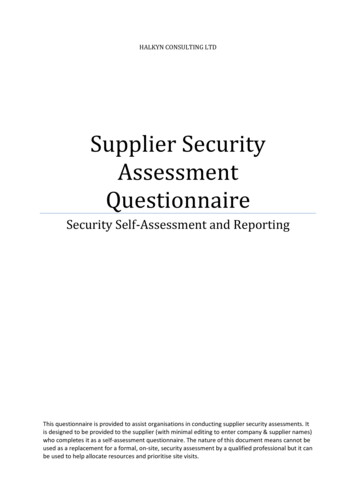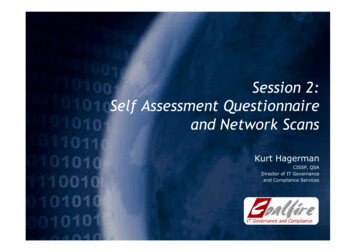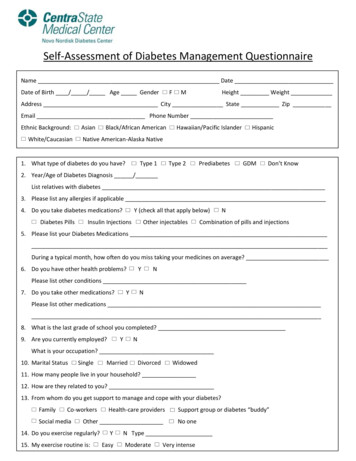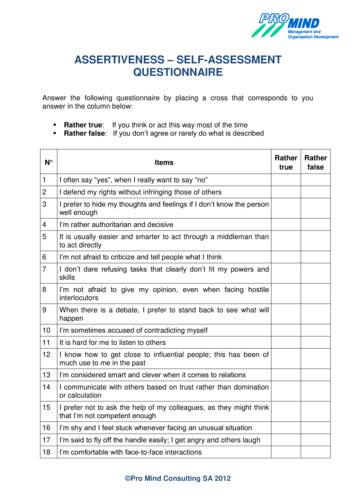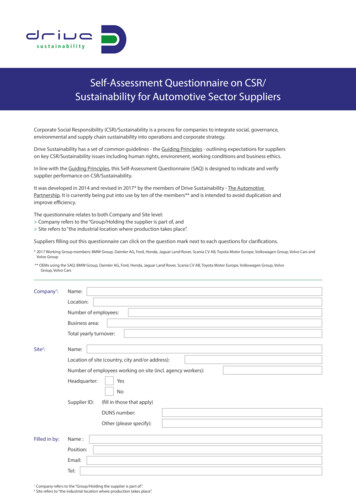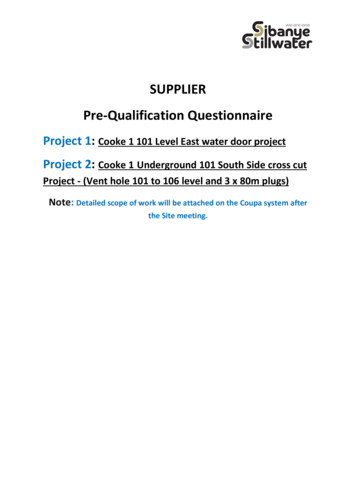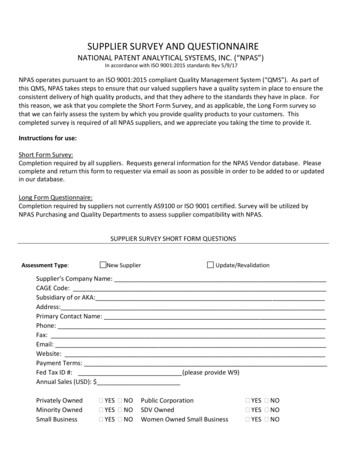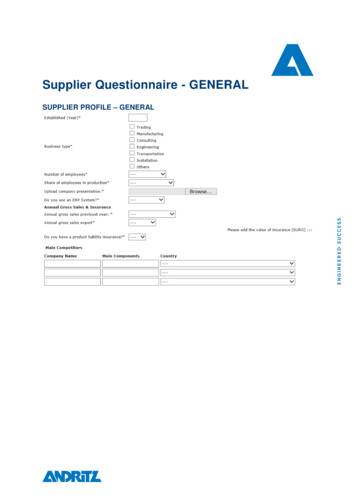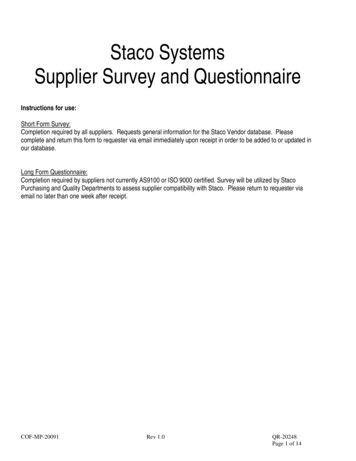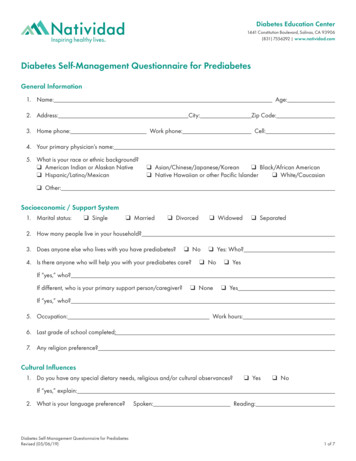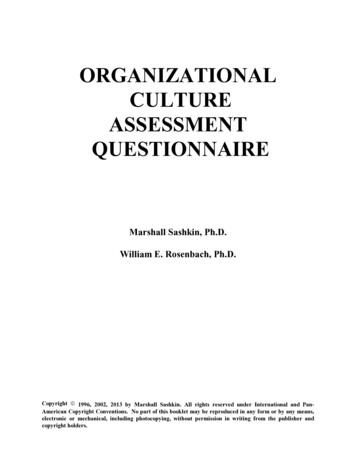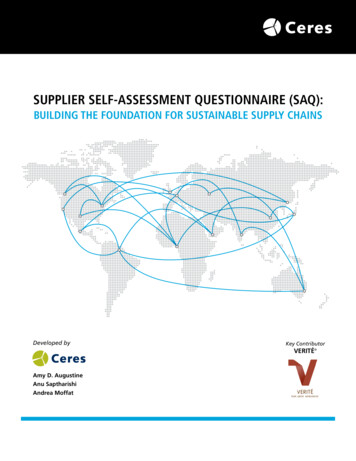
Transcription
SUPPLIER SELF-ASSESSMENT QUESTIONNAIRE (SAQ):BUILDING THE FOUNDATION FOR SUSTAINABLE SUPPLY CHAINSDeveloped byKey ContributorVERITÉ Amy D. AugustineAnu SaptharishiAndrea Moffat
About UsCeres is an advocate for sustainability leadership. Ceres mobilizes a powerful network of investors, companies, andpublic interest groups to accelerate and expand the adoption of sustainable business practices and solutions to build ahealthy global economy. Learn more at www.ceres.org.Verité. For over 15 years Verité has collaborated with the private sector to generate understanding, create tools,and develop systemic solutions to serious supply chain problems including modern-day slavery, child labor, systemicdiscrimination, dangerous working conditions, and unpaid work. For more information, see www.verite.org.AcknowledgementsThis self-assessment tool was made possible through support from the United Technologies Corporation Foundation.The opinions expressed in the report are those of the authors and do not necessarily reflect the views of the sponsor.Ceres wishes to express sincere appreciation to Verite for its valuable input in the creation of this tool. The socialindicators in particular represent Verite’s in-depth knowledge and expertise on leveraging assessments to identify andaddress supply chain issues.Ceres also wishes to thank the Rockefeller Foundation for supporting our efforts to advance sustainable supply chains.As part of the research process undertaken in the development of this tool, we reviewed a wide range of existinginitiatives to ensure coordination and consistency, including the Electronic Industry Citizenship Coalition (EICC), theGlobal Social Compliance Program (GSCP), Sedex, and a number of corporate supply chain initiatives. We wish to thankthese groups, as well as the many companies, suppliers, and environmental and social public interest groups, whoprovided important insight and expertise. We also wish to thank our colleagues, particularly Natasha Scotnicki, forsharing their knowledge and support.For more information, please visit www.ceres.org/issues.supply-chain.Layout and design by Cave Dog Studio.For more information, contact:Amy AugustineDirector, Corporate ProgramCeresaugustine@ceres.orgTel: 1-617-247-0700 x156CopyrightThis work is licensed under the Creative Commons Attribution-Noncommercial-ShareAlike 3.0 Unported License.To view a copy of this license, visit http://creativecommons.org/licenses/by-nc-sa/3.0 or send a letter to:171 Second Street, Suite 300San Francisco, California, 94105, USSupplier Self-Assessment Questionnaire (SAQ): Building the Foundation for Sustainable Supply Chains2
How to Use This Supplier Self-Assessment Questionnaire (SAQ)Supplier GuidanceIncreasingly companies are realizing in order to effectively manage their sustainability impacts, which compriseeconomic as well as environmental, social, and governance (ESG) impacts, they must ensure their suppliers are doingthe same. As such, more and more companies are engaging suppliers on these issues, encouraging integration ofESG sustainability into core decision-making and implementation of leading practices for improving supply chainsustainability performance.This has led to a proliferation of initiatives aimed at assessing and improving supply chain sustainability performance,some of which you as a supplier may have experienced. Our research has demonstrated that the majority of theseinitiatives focus exclusively on one aspect of sustainability or another, which leads to suppliers having to complete amyriad of self-assessment questionnaires (SAQs).Our intent with this questionnaire is to offer a harmonized approach, allowing one SAQ to demonstrate the importantsteps you as a supplier are taking to effectively identify and manage ESG risks and opportunities.Self-assessments are a valuable tool in any supply chain sustainability program. They can help you evaluate, manage,and communicate your ESG policies, practices, and performance. In addition, addressing the issues highlighted inthis SAQ can help you identify efficiencies, realize cost savings and productivity benefits, and set the stage forproduct innovation.The SAQ asks you to collect information on the following topics:I. General Company InformationXFacility InformationXWorkforce ProfileXEmployment RelationshipXAir EmissionsXPollution PreventionXWater ManagementXOther Raw MaterialsXWaste ManagementXTransportationXPackagingII. EnvironmentXManagement Systemsand TrainingXGreenhouse Gas Emissionsand Energy UsageIII. SocialXWorkplace ManagementXDiscriminationXCompensationXHealth & SafetyXXHours of WorkXForced LaborFreedom of Association& Collective BargainingXChild Labor& Young WorkersXHarassment & AbuseXDisclosureIV. GovernanceXAccountabilityXSupplier ManagementXGrievance and RemediationXStakeholder EngagementSupplier Self-Assessment Questionnaire (SAQ): Building the Foundation for Sustainable Supply Chains3
Two areas critical to developing and demonstrating effective management of sustainability issues are stakeholderengagement and comprehensive disclosure of sustainability performance and impacts. While companies, investors,and other stakeholders are increasingly seeking supplier disclosure of sustainability policies, practices, and performance,along with stakeholder engagement, for many suppliers such public disclosure remains in its nascent stage. Thispresents a leadership opportunity for any supplier currently engaging with stakeholders in its community—includingcommunity groups, NGOs, and government—or publicly disclosing ESG data. The governance section of the SAQallows those suppliers currently engaging in these areas to demonstrate their efforts, while providing others with keyindicators for future reporting.To complete this questionnaire, you may wish to develop a self-assessment strategy in order to consider how best togather the data you need. We recommend assigning responsibility to a senior manager within the company or to ahuman resources or corporate responsibility director.It is also helpful to consult a variety of resources, including company policies, certificates, wage slips, and records.Speaking with relevant colleagues, for example health and safety officers and human resource managers, is alsoimportant to gaining a clear picture of the realities at your facility. Workers in your facility are a valuable resource,and it may be impossible to get accurate information without their input. Interviewing workers will be particularlyimportant if your facility employs migrant workers either directly or through a broker.Suppliers are encouraged to respond candidly and completely to the questionnaire, establishing a true baselineof ESG practices and management from which future performance improvements and impact can be tracked, measured,and communicated. Answers can be entered directly into the questionnaire and additional documentation attached,as needed.The SAQ is not a means to an end, but rather the first step in the development of a constructive dialogue between youand your customers—one that provides an opportunity to build and strengthen relationships with both current andpotential business partners.Supplier Self-Assessment Questionnaire (SAQ): Building the Foundation for Sustainable Supply Chains4
I. GENERAL INFORMATIONI.A. Facility InformationI.A.1Name of FacilityAddress of FacilityI.A.2Contact NameTitleI.A.3Date of Self-AssessmentI.A.4Name, City & Country of Facility Owners or Parent/Holding Company:Detail:I.A.5List the names and addresses of all sub-contractors. Describe the tasks and processesthey perform for the facility. Attach additional documentation, as needed.Detail:I.A.6Detail:Detail:List the names and addresses of all labor brokers used to source labor (foreign ordomestic) at this facility (if applicable). Attach additional documentation, as needed.Detail:Detail:Detail:I.B. Workforce ProfileI.B.1Total number of employees at the facility:Number:I.B.2Percentage of employees that are male/female.M (%):F (%):5
I. GENERAL INFORMATION (continued)I.B.3Percentage of employees that are foreign/migrant workers.%:I.B.4Number of temporary contract workers employed by the facility.Number:I.C. Employment RelationshipI.C.1Contract workers are under contract to:I.C.2If contract workers are migrant workers, which countries of origin are represented?Attach additional documentation, as needed.Employer (#):Broker (#):Other (#):Detail:I.C.3Does the facility have procedures to ensure contract workers are not required to payan excessive recruitment fee or lodge a deposit with their labor broker?YesNoI.C.4Does the facility have procedures to ensure freedom of movement of contractworkers is not unreasonably restricted?YesNoI.C.5Does the facility have a system in place to ensure that contract labor providersadhere to all relevant labor laws?YesNoI.C.6Are all employees provided a written employment agreement with the facility in alanguage that they understand?YesNoI.C.7Does the facility maintain a personnel file on every employee?YesNoII. ENVIRONMENTII.A. Management Systems and TrainingII.A.1Does the facility have a management system in place, or is it developing one, toassess environmental risks associated with production?YesNoII.A.2Is the facility management system in compliance with applicable environmental lawsand regulations?YesNoII.A.3Does the facility have up-to-date ISO 14001, RC 14001, or EMAS certification?YesNoPlease list relevant certifications:6
II. ENVIRONMENT (continued)II.A.4Does the facility hold the necessary license(s) or permit(s) for and has the facility received any fines,prosecution, or warnings by regulators in relation to (select all that apply):License(s) or Permit(s):Fines, prosecution, or warnings by regulators:Air emissionsAir emissionsStorage or use of hazardous substancesStorage or use of hazardous substancesWastewater managementPreventing soil & groundwatercontaminationWaste issuesWastewater managementWaste issuesII.A.5Are environmental policies, practices, and expectations communicated to allemployees and suppliers in local or appropriate languages?YesNoII.A.6Are employees trained on relevant environmental matters, including(select all that apply):YesNoYesNoYesNoII.A.7Air emissionsWastewater managementManagement & use of hazardoussubstancesWaste management,including hazardous wastePreventing soil & groundwatercontaminationWater useDoes the facility have established environmental targets and objectives to improveenvironmental performance?If yes, what are the targets and objectives?II.A.8Does the facility review its environmental performance annually?II.B. Greenhouse Gas (GHG) Emissions and Energy UsageII.B.1Does the facility monitor and track energy consumption and conducton-site energy audits?YesNoII.B.2Does the facility have a system in place to reduce the environmental impact ofenergy use and greenhouse gases?YesNoII.B.3Does the facility have a program and/or procedures to reduce the use of energy?YesNoII.B.4Does the facility have goals and targets to reduce GHG emissions?YesNoIf yes, what are the targets?What is the total annual GHG emissions in the most recent year measured(enter in total metric tons CO2e)?Tons CO2e:7
II. ENVIRONMENT (continued)II.B.5Does the facility have set goals and targets in relation to increased energy efficiency?YesNoYesNoIf yes, what are the targets?II.B.6Does the facility report GHG emissions and climate change strategy to the CarbonDisclosure Project (CDP) or publicly disclose an equivalent amount and type ofinformation on an annual basis?II.C. Air EmissionsII.C.1Does the facility regularly test air emissions (i.e. NOx, SOx, mercury, hazardousair pollutants)?YesNoII.C.2Does the facility have a system in place to manage air emissions?YesNoII.C.3Does the facility have set targets in relation to reducing air emissions?YesNoYesNoIf yes, what are the targets?II.C.4Does the facility have pollution prevention devices on chimneys, vents, and extractionsystems?II.D. Water ManagementII.D.1Does the facility have a system in place to manage and monitor water withdrawalsand consumption?YesNoII.D.2Does the facility have a program and/or procedures to reduce water use orreuse/recycle water?YesNoII.D.3Does the facility have set targets to reduce water consumption?YesNoIf yes, what are the targets?II.D.4Does the facility have a system in place to address wastewater generationand management?YesNoII.D.5Does the facility treat wastewater prior to off-site discharge?YesNoIf yes, what is the standard?8
II. ENVIRONMENT (continued)II.D.6Does the facility identify the sources of its water (e.g. aquifers, municipal watersourced from local water body, harvested rainwater, etc.)?YesNoDoes the company assess external supply and quality risks related to thesewater sources?YesNoII.E. Waste ManagementII.E.1Does the facility have a program and/or procedures to reduce or eliminate pollutionand waste in its operations?YesNoII.E.2Does the facility have a recycling program to reduce or eliminate pollution and wastein its operations?YesNoII.E.3Does the facility have a program and/or procedures to manage and dispose ofhazardous waste (if applicable), wastewater, solid waste, and airborne emissions?YesNoII.E.4Does the facility have set targets to reduce the volume of waste generated?YesNoIf yes, what are the targets?II.E.5Does the facility maintain records of off-site transfer, treatment, and disposalof waste?YesNoII.E.6If the facility uses external waste contractors, does it conduct regular auditsof those contractors?YesNoDo contractors have relevant certifications?YesNoHave contractors received any compliance violations within the past 3 years?YesNoYesNoYesNoYesNoII.F. PackagingII.F.1Does the facility have goals and targets to reduce, reuse, and recycle the amount ofpackaging used for its products?If yes, what are the targets?II.F.2Does the facility incorporate packaging reduction, reuse, and recycling in itspurchasing practices?II.G. Pollution PreventionII.G.1Does the facility consider Design for Environment (DfE) in its developmentof products?9
II. ENVIRONMENT (continued)Does the facility use life cycle assessment (LCA) as part of determining chemicalselection for product inputs?YesNoDoes the facility use chemical hazard assessment and/or comparative chemical hazardassessment as part of determining chemical selection for product inputs?YesNoII.G.3Does the facility assess whether substances stored, used, or handled on-site areprohibited by national or international laws or protocols?YesNoII.G.4Does the facility have a system in place to address pollution prevention andmanagement of hazardous and potentially hazardous substances?YesNoII.G.5Does the facility maintain up-to-date material safety data sheets (MSDS) for allhazardous substances used on-site?YesNoII.G.6Does the facility set targets in relation to eliminating or reducing hazardoussubstances on-site?YesNoYesNoII.G.2If yes, what are the targets?II.G.7Does the facility conduct tests to identify impact on soil and groundwater fromfacility operations?II.H. Other Raw MaterialsII.H.1Does the facility keep inventory of all chemical substances used, stored, processed,and manufactured?YesNoII.H.2Does the facility have a program and/or procedures to reduce the use of resources(other than water), and promote sustainable natural resource practices?YesNoII.H.3Does the facility have a policy statement and/or management system that addressesconflict minerals?YesNoII.H.4Does the company engage with the government, commercial contacts, or civil societygroups regarding conflict minerals and/or rare earth materials?YesNoYesNoIf yes, with whom and how?II.I. TransportationII.I.1Does the facility have in place targets and programs to reduce overall sustainabilityimpacts by managing transportation logistics (e.g. prioritizing low impacttransportation modes)?If yes, what are the targets and programs?10
III. SOCIALIII.A. Workplace ManagementIII.A.1Does the facility have a written corporate responsibility policy or statement ofcommitment that defines its approach to labor, health, and safety standards?YesNoIII.A.2Does the facility have policies that prohibit forced labor and child labor?YesNoIII.A.3Does the facility have written personnel policies that cover (select all that apply):Does the policy cover all workers, including migrant workers?YesNoIII.A.4Does the facility have a management system in place, or is it developing one,to assess labor, health, and safety risks?YesNoIII.A.5Is the facility performance management system in compliance with applicable sociallaws and regulations?YesNoIII.A.6Does the facility have up-to-date SA8000, ETI, or other recognized certification?YesNoBenefits and deductionsOvertime wage ratesDiscipline and terminationRegular hoursGrievance proceduresVacation and leaveHarassment and abuseWagesOvertime hoursPlease list relevant certifications:III.A.7Does the facility have a system in place for employee appraisal that coversregular workers and probationary employees/trainees?YesNoIII.A.8Are formal and written policies and procedures for disciplining and terminatingemployees standardized throughout the facility?YesNoIII.A.9Does the facility strictly prohibit physical punishment of employees as adisciplinary measure?YesNoIII.A.10Are labor, health, and safety policies, practices, and expectations communicated to allemployees and suppliers in local or appropriate languages?YesNoWhat communication vehicles are used? (Select all that apply)Bulletin board postingFormal trainingElectronic mailManager meetingEmployee handbook/literatureWebsite11
III. SOCIAL (continued)III.B. Health & SafetyIII.B.1. FacilityIII.B.1.aTo which laws and regulations governing environment, health, and safety does thefacility adhere?Detail:III.B.1.bDoes the facility have up-to-date OHSAS 18001, ANSI Z10, CSA Z1000, BSI 8800,or OSHA VPP certification?YesNoPlease list relevant certifications:III.B.1.cDoes the facility have procedures in place to ensure appropriate machinery is wellmaintained and equipped with necessary safety devices?YesNoIII.B.1.dDoes the facility have written procedures for the safe storage, use, and disposal ofeach hazardous material used in production (if applicable), in language(s) workersunderstand?YesNoIII.B.1.eDoes the facility have procedures in place to ensure appropriate Personal ProtectionEquipment (PPE) is provided to employees?YesNoIf yes, provide a list of Personal Protection Equipment (PPE) distributed and thenumber of employees using it:Detail:III.B.1.fHow often are noise levels and air quality in the facility regularly monitored?III.B.1.gDoes the facility have a written emergency response plan and fire evacuationprocedure?YesNoIII.B.1.hHas the emergency response plan and fire evacuation procedure beencommunicated to all parties that could be affected by the emergency in localor appropriate languages?YesNoIII.B.1.iHow often does the facility conduct emergency drills?Times per year:Times per year:12
III. SOCIAL (continued)III.B.1.jAre all emergency exits unobstructed and unlocked from the inside at all timesduring working hours?YesNoIII.B.1.kDoes the facility have procedures in place to ensure employees are not deniedpermission or delayed from leaving the facility under reasonable circumstances(e.g. in the event on an emergency or personal urgency)?YesNoYesNoHas the facility operated without serious injury and/or fatality over the past year?YesNoOver the past three years?YesNoIII.B.2. Facility Emergency ManagementIII.B.2.aDoes the facility have well-stocked, unlocked first aid stations at everyproduction site?III.B.2.bAre all employees trained on relevant health and safety matters, including(select all that apply):III.B.2.cEmergency managementMachine safeguardingHazardous materials handlingOccupational health and safetyLiving conditionsPersonal protection equipmentIII.B.3. Dormitory (if applicable)III.B.3.aAre all emergency exi
Supplier Self-Assessment Questionnaire (SAQ): Building the Foundation for Sustainable Supply Chains 4 Two areas critical to developing and demonstrating effective management of sustainability issues are stakeholder engagement and comprehensive disclosure of sustainabi
